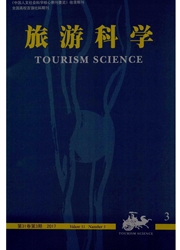

 中文摘要:
中文摘要:
自然保护区是保护生物多样性的基石,旅游是保护区的重要发展方式。立足于景观尺度,基于3S技术和景观指数,研究了1975~2007年九寨沟自然保护区在旅游业快速发展背景下景观格局的变化。结果表明:近33 a来,保护区各类景观都发生了不同程度的变化;草地、疏林/灌丛、耕地为净减少,而林地、冰雪/裸岩、建设用地、水域为净增加;从转出的比例上看,建设用地最大(132.07%),其次是耕地(100%)、草地(6.06%)、疏林/灌丛(5.35%)、林地(4.47%)、冰雪/裸岩(3.21%)、水域最小(2.07%);在人类活动和自然过程的共同作用下,到1997年景观破碎化程度不断增加,到2007年则有所恢复。总的来讲,采伐活动与自然恢复之间的综合作用是九寨沟景观变化的主要驱动因素,旅游业发展对景观变化的影响相对较小。旅游发展促进了保护区整体植被的恢复,但也增加了景区内的建筑用地面积,改变了景区局部地区的植被格局。只有坚持"保护第一"的原则,对旅游进行科学的规划管理才能实现保护与发展的共赢。
 英文摘要:
英文摘要:
Nature reserve is the cornerstone of biodiversity conservation,and tourism is an important mode of development of the nature reserve.Based on the landscape scale,3S technology and landscape indices,the paper discussed the change of the landscape patterns in the context of rapid development of tourism in Jiuzhaigou nature reserve during 1975~2007.The results showed that various landscape types of the natural reserve had taken place in different degrees during 33 years.The area of grassland,woodland/shrub,cultivated land had a net decrease,whereas the area of forestland,snow/naked rock,construction land,waters had a net increase.From the point of view of transferred out of proportion,construction land was the largest(132.07%),followed by cultivated land(100%),grassland(6.06%),woodland/shrub(5.35%),forestland(4.47%),snow/naked rock(3.21%),whereas waters(2.07%) was the smallest.Under human activities and natural recovery processes,the degree of landscape fragment continued to increase by 1997;but turned better by 2007.In general,the comprehensive action of forest cutting and natural restoration was the primary driving factor,while the effect of tourism development was relative low for Jiuzhaigou's landscape changing.Development of tourism had promoted the whole recovery of vegetation in natural reserve,but also added construction land and changed the landscape patterns of vegetation.Only when we instill the principle of "conversation firstly",and manage scientifically,protection and development can reach a win-win situation.
 同期刊论文项目
同期刊论文项目
 同项目期刊论文
同项目期刊论文
 Simulation and Prediction of Decarbonated Development in Tourist Attractions Associated with Low-car
Simulation and Prediction of Decarbonated Development in Tourist Attractions Associated with Low-car A new improved forecasting method integrated fuzzy time series with the exponential smoothing method
A new improved forecasting method integrated fuzzy time series with the exponential smoothing method A Satisfaction Evaluation Method for Scenic Spot based on Linguistic Weighted Arithmetic Average Ope
A Satisfaction Evaluation Method for Scenic Spot based on Linguistic Weighted Arithmetic Average Ope Evaluation Model Construction and Simulation Research on Tourist Diversion Strategy in Ecotourism Sc
Evaluation Model Construction and Simulation Research on Tourist Diversion Strategy in Ecotourism Sc Research on Scenic Spot’s Sustainable Development Based on a SD Model: A Case Study of the Jiuzhai V
Research on Scenic Spot’s Sustainable Development Based on a SD Model: A Case Study of the Jiuzhai V Modeling and Pareto optimization of multi-objective order scheduling problems in production planning
Modeling and Pareto optimization of multi-objective order scheduling problems in production planning Research on Diffluent Network Prediction Model of Ecotourim Scenic Spot Based on the Dynamic Fuzzy C
Research on Diffluent Network Prediction Model of Ecotourim Scenic Spot Based on the Dynamic Fuzzy C The Dynamic Coordinated Development of a Regional Environment-Tourism-Economy System: A Case Study f
The Dynamic Coordinated Development of a Regional Environment-Tourism-Economy System: A Case Study f 期刊信息
期刊信息
